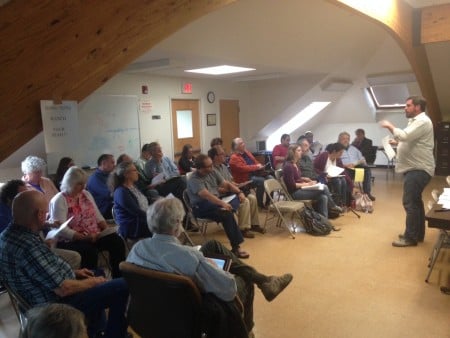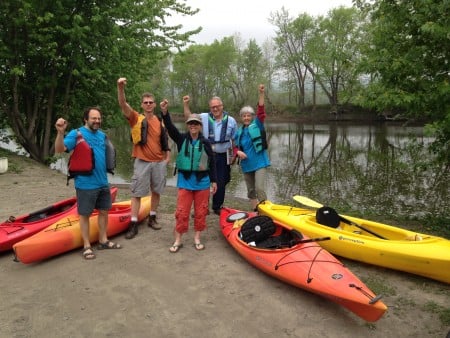New Group Forms to Protect Wallkill River Watershed

Jason West leads the first meeting of a new Wallkill River Watershed citizens group on June 4, 2015. (Photo by Dan Shapley/Riverkeeper)
View more images on our Flickr site

Jason West leads the first meeting of a new Wallkill River Watershed citizens group on June 4, 2015. (Photo by Dan Shapley/Riverkeeper)
It was a huge night for the Wallkill River June 4, as more than 40 people came together to form a new citizen watershed group that wants to achieve a “fishable and swimmable” river.
The group that gathered included environmental scientists and ecologists, representatives of the Ulster County Legislature, the planning departments of Ulster and Orange counties, the Ulster County Department of the Environment, representatives of municipal advisory boards, and community groups, including Mohonk Consultations and the Wallkill Valley Land Trust, as well as representatives of the Hudson River Estuary Program, Riverkeeper and the Hudson River Watershed Alliance, which are playing supportive roles in helping the group form.
Most importantly, the group that gathered included passionate and knowledgeable individuals devoted to volunteering time to the effort. People spoke passionately about the swimming they used to do, and want to do again. They spoke about why they love the river, how they use it and how it could be an asset on par with the Shawangunk Ridge aswater quality, access and its reputation improve. They spoke about threats to the river ranging from leaky sewers and septic systems to the proposed CPV power plant in Wawayanda and the leaching from the Orange County Landfill.
The meeting, led by Jason West, is the followup to the Future of the Wallkill River event hosted by SUNY New Paltz Center for Regional Research Education and Outreach, which was organized after West, then mayor of the Village of New Paltz, convened a group that included Riverkeeper to devise ways to protect and restore the Wallkill.
“I want to swim in the Wallkill River,” West said, summarizing his guiding vision.
“I want my two-year-old daughter to be able to swim in the Wallkill,” said Neil Bettez, a research ecologist with the Cary Institute in Millbrook. “This problem is tractable. We can do this.”
“The river is clear 15 feet on some days. It’s beautiful. Other days it stinks,” said Craig Chapman, owner of New Paltz Kayak Tours, who urged people to recognize what makes the river a rich resource for recreation today, even while the focus turns to fixing what ails it.
Since 2012, Riverkeeper has been working with community partners to sample for fecal indicating bacteria in the Wallkill and Rondout watershed — the largest watershed in the tidal Hudson River Estuary. Riverkeeper’s community monitoring project, funded in its first year with a grant from the UPS Foundation, and supported in subsequent year by donations from the HSBC Water Programme and many other foundations and individuals, has helped inspire the formation of this group.
The audience at the Future of the Wallkill River event in April clearly expressed its desire to get to work on projects that will improve the river’s water quality, habitat and access. The group has the benefit of the Wallkill River Watershed Conservation and Management Plan, a thorough characterization of the watershed that lays out a number of areas for further work.
The members of the new Wallkill Watershed group — as yet unnamed — raised their hands to volunteer for a number of projects, ranging from a series of “boat brigades” that will give people a chance to get on the water, to know it better, learn about its conditions and report any problems observed. (Join the boat brigades departing on June 6 from Wallkill, June 27 from New Paltz or July 25 from Rosendale.) Riverkeeper is helping to advise those taking part, based on experience from our own boat patrols of the Hudson River.

Kayakers prepare for a trash cleanup on the Wallkill River May 9 as part of the 2015 Riverkeeper Sweep. Photo by Dan Shapley/Riverkeeper
Other projects that drew volunteer interest include stormwater outfall mapping — a key goal in the Town and Village of New Paltz, where discharges from the stormwater outfalls are now regulated; research; replicating the Future of the Wallkill River event in other parts of the watershed; regulatory options for improving the Wallkill; advocacy, communications and education. Smaller groups are planning to meet on each topic and report back next month on their progress.
“We have watchdogs for the Hudson River,” Maureen Cunningham, director of the Hudson River Watershed Alliance, said during her presentation, about the various ways more than 20 other watershed groups in the Hudson Valley operate. “We don’t have that for all of the … (roughly) 8,000 miles of streams in the Hudson River Estuary Watershed.”
Now, the Wallkill River has a watchdog.
